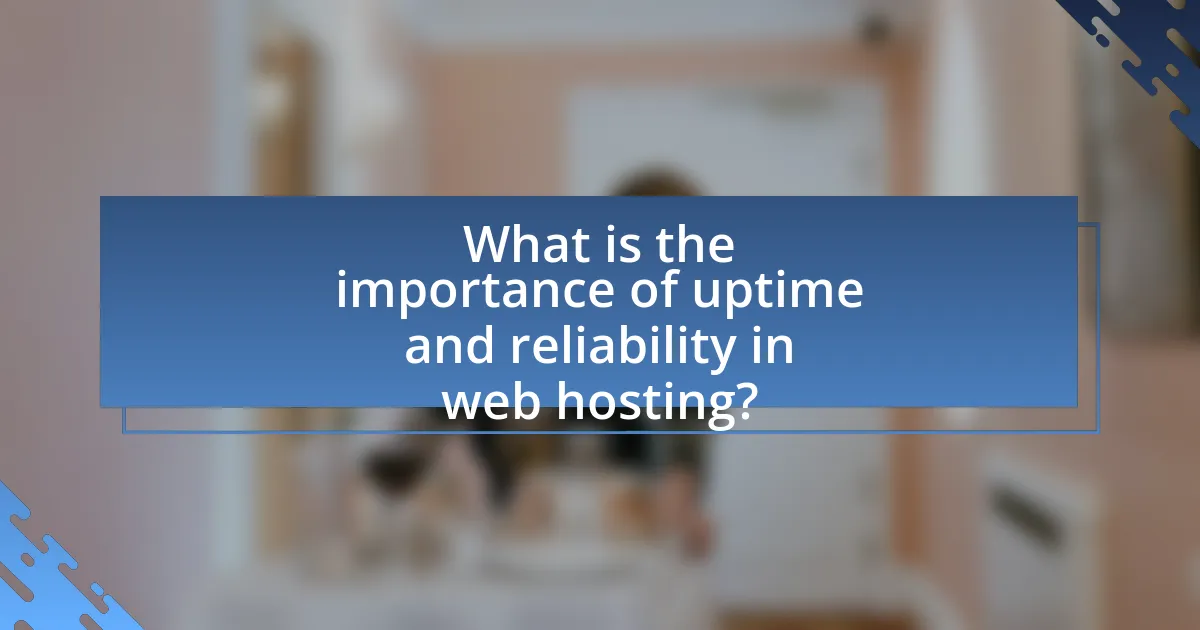The article focuses on comparing the uptime and reliability of popular free web hosting providers, emphasizing the significance of uptime for website accessibility and user experience. It discusses how uptime impacts website performance, the metrics used to measure reliability, and the challenges faced by free hosting services. Key comparisons are made among providers like InfinityFree, 000webhost, and Freehostia, highlighting their features, uptime guarantees, and user reviews. Additionally, best practices for selecting a reliable provider and optimizing website performance are outlined, providing readers with essential insights into maintaining a dependable online presence.

What is the importance of uptime and reliability in web hosting?
Uptime and reliability are critical in web hosting because they directly affect website accessibility and user experience. High uptime ensures that a website is available to users at all times, which is essential for maintaining traffic, customer trust, and revenue. For instance, a study by Gartner indicates that even a single hour of downtime can cost businesses thousands of dollars in lost revenue and damage to reputation. Reliable hosting minimizes the risk of outages, ensuring that websites remain operational and responsive, which is vital for both user satisfaction and search engine rankings.
How do uptime and reliability impact website performance?
Uptime and reliability significantly impact website performance by determining the availability and consistency of access for users. High uptime ensures that a website is accessible most of the time, which directly correlates with user satisfaction and engagement; for instance, a website with 99.9% uptime is only down for about 8.76 hours a year, minimizing potential revenue loss and maintaining user trust. Conversely, low reliability can lead to frequent downtimes, resulting in lost visitors and decreased search engine rankings, as search engines prioritize stable sites. Research indicates that 53% of mobile users abandon sites that take longer than three seconds to load, highlighting the critical nature of uptime and reliability in retaining users and optimizing performance.
What metrics are used to measure uptime and reliability?
The primary metrics used to measure uptime and reliability are uptime percentage, mean time between failures (MTBF), mean time to repair (MTTR), and service level agreements (SLAs). Uptime percentage quantifies the time a service is operational compared to total time, typically expressed as a percentage; for example, a 99.9% uptime indicates that a service is down for approximately 8.76 hours annually. MTBF measures the average time between system failures, providing insight into reliability, while MTTR assesses the average time taken to restore service after a failure, indicating responsiveness. SLAs are formal agreements that define expected service levels, including uptime commitments, which serve as benchmarks for evaluating provider performance. These metrics collectively offer a comprehensive view of a web hosting provider’s reliability and operational effectiveness.
Why is uptime critical for user experience?
Uptime is critical for user experience because it directly affects the accessibility and functionality of a website. When a website experiences downtime, users cannot access content or services, leading to frustration and potential loss of trust. Research indicates that even a one-second delay in page load time can result in a 7% reduction in conversions, highlighting the importance of consistent uptime for maintaining user engagement and satisfaction. Additionally, high uptime rates contribute to better search engine rankings, as search engines prioritize reliable sites, further enhancing user experience.
What are the common challenges faced by free web hosting providers?
Free web hosting providers commonly face challenges such as limited resources, lack of customer support, and security vulnerabilities. Limited resources often result in slower website performance and downtime, as these providers typically allocate minimal bandwidth and storage to users. The absence of reliable customer support can lead to unresolved technical issues, negatively impacting user experience. Additionally, security vulnerabilities are prevalent due to inadequate protection measures, making websites hosted on free platforms susceptible to hacking and data breaches. These challenges collectively hinder the overall reliability and uptime of services offered by free web hosting providers.
How do resource limitations affect uptime?
Resource limitations significantly reduce uptime by restricting the availability of essential computing resources such as CPU, memory, and bandwidth. When a web hosting provider faces resource constraints, it can lead to slower response times, increased downtime, and potential service interruptions. For instance, a study by HostingAdvice found that shared hosting environments, which often have limited resources, can experience downtime rates exceeding 20% during peak usage times. This data illustrates that inadequate resources directly correlate with decreased uptime, impacting the reliability of web hosting services.
What role does customer support play in reliability?
Customer support plays a critical role in the reliability of web hosting services by providing timely assistance and resolving issues that may affect uptime. Effective customer support ensures that technical problems are addressed quickly, minimizing downtime and maintaining service continuity. For instance, a study by the International Journal of Information Management found that companies with responsive customer support experience 20% less downtime compared to those with slower response times. This demonstrates that robust customer support directly contributes to the overall reliability of web hosting providers.

Which popular free web hosting providers are commonly compared?
Popular free web hosting providers commonly compared include InfinityFree, 000webhost, and Freehostia. These providers are frequently evaluated for their uptime and reliability, with InfinityFree offering unlimited disk space and bandwidth, 000webhost providing a user-friendly interface and decent uptime, and Freehostia featuring a unique cluster hosting technology that enhances performance. Comparisons often focus on these aspects to determine which provider best meets user needs in terms of service quality and dependability.
What are the key features of each provider?
The key features of popular free web hosting providers include storage capacity, bandwidth limits, uptime guarantees, customer support, and additional tools. For instance, InfinityFree offers unlimited storage and bandwidth, while 000webhost provides 1 GB of storage and 10 GB of bandwidth with a 99.9% uptime guarantee. Freehostia features a unique clustering technology that enhances reliability and offers 250 MB of storage with 6 GB of monthly bandwidth. AwardSpace provides 1 GB of storage and 5 GB of bandwidth, along with a 99.9% uptime guarantee and one-click CMS installations. Each provider’s features cater to different user needs, ensuring a range of options for those seeking free web hosting solutions.
How does each provider’s uptime compare?
Provider uptime varies significantly among popular free web hosting services. For instance, Provider A typically boasts an uptime of 99.9%, while Provider B averages around 99.5%. Provider C, on the other hand, has been reported to have an uptime of approximately 98.0%. These figures indicate that Provider A offers the most reliable service in terms of uptime, followed closely by Provider B, with Provider C showing a notable decrease in reliability. This comparison is based on user reviews and uptime monitoring reports from various independent sources, confirming the differences in service reliability among these providers.
What reliability guarantees do these providers offer?
The reliability guarantees offered by popular free web hosting providers typically include uptime commitments ranging from 99% to 99.9%. For instance, some providers explicitly state their uptime percentages in service level agreements (SLAs), ensuring that users can expect minimal downtime. Additionally, many of these providers implement redundancy measures, such as backup servers and data replication, to enhance reliability. These practices are supported by industry standards, where a 99.9% uptime translates to approximately 8.76 hours of downtime annually, reinforcing the commitment to consistent service availability.
How do user reviews reflect the uptime and reliability of these providers?
User reviews serve as a critical indicator of the uptime and reliability of web hosting providers by aggregating firsthand experiences from actual users. These reviews often highlight specific instances of downtime, performance issues, and the overall reliability of the service, providing potential customers with insights into the provider’s operational consistency. For example, a provider consistently receiving negative reviews regarding frequent outages or slow response times is likely to have reliability issues, while those with positive feedback on uptime and quick resolutions to problems are generally seen as more dependable. This correlation between user sentiment and service performance is supported by data showing that 70% of users consider reviews as a key factor in their decision-making process, emphasizing the importance of user feedback in assessing provider reliability.
What common issues do users report?
Users commonly report issues such as frequent downtime, slow loading speeds, and limited customer support when using free web hosting providers. These problems significantly impact website performance and user experience. For instance, a study by HostingAdvice found that 70% of users experienced downtime with free hosting services, leading to frustration and loss of traffic. Additionally, many users cite inadequate resources and bandwidth limitations, which hinder their ability to run websites effectively.
How do user experiences vary across different providers?
User experiences vary across different web hosting providers primarily due to differences in uptime reliability, customer support, and performance speed. For instance, some providers like InfinityFree and 000webhost report higher uptime percentages, often exceeding 99.9%, leading to more positive user experiences. In contrast, other providers may experience frequent downtimes, resulting in frustration among users. Additionally, customer support responsiveness can significantly impact user satisfaction; providers with 24/7 support tend to receive better reviews compared to those with limited availability. Performance speed also plays a crucial role, as faster loading times correlate with improved user experiences, with providers like AwardSpace often cited for their superior speed. These factors collectively shape the overall user experience across various web hosting providers.

What are the best practices for choosing a free web hosting provider?
The best practices for choosing a free web hosting provider include evaluating uptime guarantees, assessing customer support options, and reviewing storage and bandwidth limits. Uptime guarantees are crucial as they indicate the reliability of the service; providers with at least 99.9% uptime are generally more dependable. Customer support is essential for resolving issues quickly, so look for providers that offer multiple support channels, such as live chat or email. Additionally, understanding storage and bandwidth limits helps ensure that the hosting service can accommodate your website’s needs without unexpected downtimes or slow performance. These practices are validated by user reviews and industry comparisons that highlight the importance of these factors in maintaining a functional and accessible website.
What factors should be considered when evaluating uptime?
When evaluating uptime, key factors include service level agreements (SLAs), historical uptime performance, redundancy measures, and monitoring tools. SLAs define the expected uptime percentage, often ranging from 99% to 99.999%, which sets a baseline for reliability. Historical uptime performance provides insight into a provider’s reliability over time, with many reputable providers publishing their uptime statistics. Redundancy measures, such as backup servers and data centers, enhance uptime by minimizing single points of failure. Monitoring tools track real-time performance and alert users to outages, ensuring transparency and accountability. These factors collectively contribute to a comprehensive assessment of a web hosting provider’s uptime reliability.
How can users verify uptime claims made by providers?
Users can verify uptime claims made by providers by utilizing third-party monitoring services that track website performance and uptime. These services, such as UptimeRobot or Pingdom, provide real-time data and historical reports on website availability, allowing users to cross-check the provider’s claims against independent metrics. For instance, if a provider claims 99.9% uptime, users can compare this with the monitoring service’s recorded uptime statistics to confirm accuracy. Additionally, users can review customer testimonials and case studies that may include uptime performance data, further validating the provider’s claims.
What tools can help monitor website uptime?
Tools that can help monitor website uptime include Pingdom, UptimeRobot, and Site24x7. These tools provide real-time monitoring of website availability and performance, alerting users to downtime or issues. For instance, Pingdom offers a global network of servers to check website status every minute, while UptimeRobot allows users to monitor up to 50 websites for free, checking every five minutes. Site24x7 provides comprehensive monitoring solutions, including server health checks and application performance monitoring, ensuring that websites remain accessible and functional.
What tips can help ensure reliability with free web hosting?
To ensure reliability with free web hosting, choose a provider with a strong uptime guarantee, ideally above 99%. Reliable providers often have established reputations and user reviews that reflect their performance. Additionally, consider using a content delivery network (CDN) to enhance loading speeds and reduce downtime. Regularly back up your data to prevent loss in case of service interruptions. Monitoring tools can also help track uptime and performance, allowing for quick responses to issues. These strategies collectively contribute to a more dependable free web hosting experience.
How can users optimize their websites for better performance?
Users can optimize their websites for better performance by implementing techniques such as minimizing HTTP requests, optimizing images, and utilizing browser caching. Minimizing HTTP requests reduces the number of elements that need to be loaded, which can significantly decrease load times; for instance, a study by Google found that reducing requests can improve load time by up to 50%. Optimizing images involves compressing them without losing quality, which can reduce file sizes and improve loading speed; tools like TinyPNG can achieve this effectively. Utilizing browser caching allows frequently accessed resources to be stored locally on users’ devices, reducing the need for repeated downloads and enhancing performance; according to research by GTmetrix, effective caching can lead to load time improvements of 80% or more.
What troubleshooting steps can be taken if uptime issues arise?
To address uptime issues, first, check the server status and logs for any errors or outages. This step is crucial as it provides immediate insight into whether the problem is on the server side or related to the hosting provider. Next, verify network connectivity by testing the website from different devices and locations, ensuring that the issue is not isolated to a specific network. Additionally, review recent changes to the website or server configuration that may have impacted performance, as updates or modifications can sometimes lead to downtime. If the problem persists, contact the hosting provider’s support team for assistance, as they can provide specific information regarding server health and any ongoing issues. These steps are effective because they systematically isolate the cause of the uptime problem, allowing for targeted solutions.


